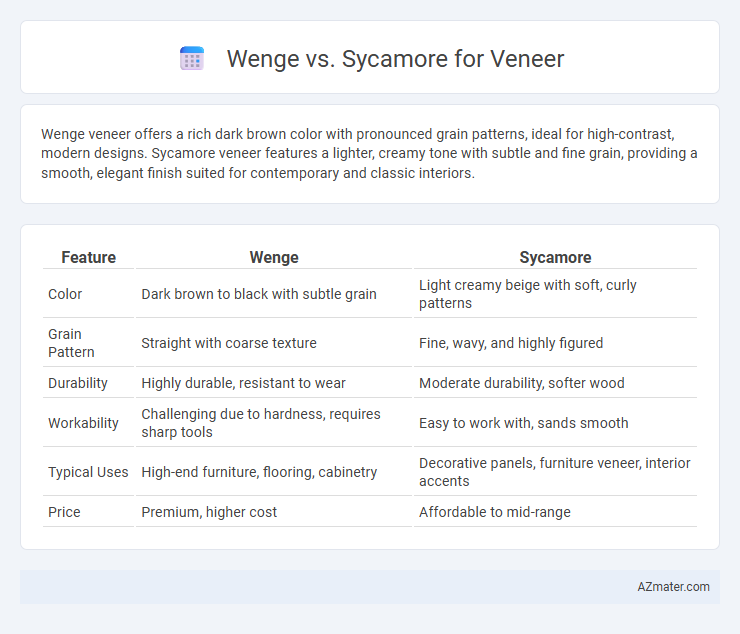Wenge veneer offers a rich dark brown color with pronounced grain patterns, ideal for high-contrast, modern designs. Sycamore veneer features a lighter, creamy tone with subtle and fine grain, providing a smooth, elegant finish suited for contemporary and classic interiors.
Table of Comparison
| Feature | Wenge | Sycamore |
|---|---|---|
| Color | Dark brown to black with subtle grain | Light creamy beige with soft, curly patterns |
| Grain Pattern | Straight with coarse texture | Fine, wavy, and highly figured |
| Durability | Highly durable, resistant to wear | Moderate durability, softer wood |
| Workability | Challenging due to hardness, requires sharp tools | Easy to work with, sands smooth |
| Typical Uses | High-end furniture, flooring, cabinetry | Decorative panels, furniture veneer, interior accents |
| Price | Premium, higher cost | Affordable to mid-range |
Introduction to Wenge and Sycamore Veneer
Wenge veneer, derived from the dark, dense wood of the Millettia laurentii tree native to Central Africa, boasts a rich chocolate-brown color with striking black streaks, offering a bold and exotic appearance ideal for luxury furniture and cabinetry. Sycamore veneer, sourced from the Acer pseudoplatanus tree commonly found in Europe and North America, features a lighter, creamy beige tone with subtle, intricate grain patterns, lending a soft and elegant aesthetic suitable for contemporary and classic interiors. Both veneers provide unique textures and color palettes, with Wenge prized for its durability and dramatic visual impact, while Sycamore is valued for its smooth finish and versatile application in fine woodworking.
Origin and Botanical Background
Wenge veneer originates from the Millettia laurentii tree, native to the tropical rainforests of Central Africa, particularly the Democratic Republic of Congo. Sycamore veneer is derived from the Acer pseudoplatanus species, commonly found in temperate regions of Europe and Western Asia. The dense, coarse grain of Wenge contrasts with the fine, even texture of Sycamore, reflecting their distinct botanical backgrounds and growth environments.
Color and Grain Characteristics
Wenge veneer features a deep, rich chocolate-brown color with subtle black streaks, offering a bold and dramatic aesthetic ideal for modern and high-contrast designs. Its grain is straight and coarse, providing a pronounced texture that enhances the wood's visual depth. Sycamore veneer, by contrast, presents a lighter, creamy beige to pale tan color with delicate, flowing grain patterns and occasional curls, lending a soft, elegant look suitable for bright and airy interiors.
Durability and Hardness Comparison
Wenge veneer is known for its exceptional durability and hardness, with a Janka hardness rating of approximately 1630, making it highly resistant to wear and dents. Sycamore veneer, by contrast, has a lower hardness rating of around 950 on the Janka scale, indicating it is softer and more prone to scratches and dents. For applications requiring long-lasting, robust surfaces, Wenge is generally preferred due to its superior strength and resilience compared to the more delicate Sycamore veneer.
Workability and Ease of Use
Wenge veneer offers excellent workability with its dense, coarse grain, requiring sharp tools for clean cuts and precise shaping during woodworking projects. Sycamore veneer is easier to handle due to its fine, even texture and moderate hardness, allowing smooth sanding and less tool strain. Both veneers respond well to adhesives and finishes, but sycamore's uniform surface often results in fewer complications during application and finishing processes.
Aesthetic Applications in Interior Design
Wenge veneer offers a rich, dark brown color with prominent black streaks, creating a bold and luxurious aesthetic ideal for contemporary interior design. Sycamore veneer features a light, creamy tone with delicate grain patterns that provide a bright and airy feel, perfect for modern and Scandinavian-inspired spaces. Both veneers enhance interior applications by adding unique texture and visual interest, with Wenge emphasizing depth and sophistication, while Sycamore promotes warmth and subtle elegance.
Cost Differences and Availability
Wenge veneer commands a higher price due to its dense, dark hardwood characteristic sourced mainly from Central Africa, making it less abundant and more costly. Sycamore veneer, more affordable and widely available from North American and European markets, offers a lighter, more uniform grain that reduces its overall cost and increases supply stability. Cost differences heavily favor sycamore for budget-conscious projects, while wenge suits premium designs demanding unique visual depth.
Environmental Impact and Sustainability
Wenge veneer is sourced from the Millettia laurentii tree native to Central Africa, facing risks due to overharvesting and slow growth, raising sustainability concerns. Sycamore veneer, derived primarily from Acer pseudoplatanus in temperate regions, benefits from faster growth rates and more sustainable forestry practices with fewer environmental impacts. Choosing sycamore veneer supports more sustainable forestry management and reduces the ecological footprint compared to the more endangered and slower-growing wenge species.
Maintenance and Longevity
Wenge veneer is highly durable and resistant to scratches and moisture, making it low-maintenance and ideal for long-lasting applications. Sycamore veneer requires more careful upkeep due to its softer wood, demanding regular cleaning and protection from humidity to prevent warping or damage. Both veneers benefit from periodic sealing, but Wenge's natural hardness contributes to a longer lifespan with less intensive maintenance.
Choosing the Right Veneer: Wenge or Sycamore?
Wenge veneer offers a rich, dark brown color with distinctive open grain patterns ideal for bold, modern designs, while Sycamore veneer features a lighter, creamy tone with subtle, uniform grain suitable for bright, airy interiors. Durability is higher in Wenge due to its dense hardwood nature, making it better for high-traffic surfaces, whereas Sycamore's softer texture allows for easier machining and finishing, perfect for intricate detailing. Selecting between Wenge and Sycamore veneers depends on desired aesthetic contrast, functional durability, and the specific application environment.

Infographic: Wenge vs Sycamore for Veneer
 azmater.com
azmater.com